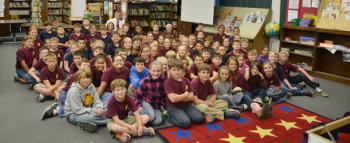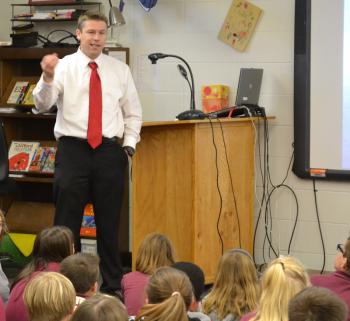
Iota Elementary fourth grade students pose with Heath Morton from KLFY News 10 after Morton spoke to them about the water cycle, hurricanes, tornadoes and much more. The school presented Morton a goodie bag to thank him for his time.

Heath Morton, KLFY News 10 meteorologist, spoke on the water cycle to Iota Elementary School fourth graders Friday afternoon. Morton also discussed weather-related careers, hurricanes and tornadoes with the students, who were filled with a variety of questions for the meteorologist.
Fourth graders visited by KLFY meteorologist
Jeannine LeJeune is the online editor for the Crowley Post-Signal. She can be reached at jeannine.lejeune@crowleytoday.com or 337-783-3450.
At Iota Elementary, the fourth graders recently-completed SRA (Science Research Associates, Inc.) unit has led to much more than just base knowledge.
The classes have spent time learning all about the water cycle and hurricanes, and the students are now working on a book, “The Louisiana Water Cycle,” based on their study unit as an extended learning project.
It is for that reason that the teachers of the fourth grade classes at Iota Elementary asked KLFY News 10 meteorologist Heath Morton to visit the school and provide more insight into the weather phenomena.
Last week, he happily obliged.
Morton spoke to the large contingent in the school library Friday afternoon and provided valuable insight into tornadoes and the weather-related careers.
A special request came from the teachers to focus some time on a raindrop’s voyage in a hurricane, perhaps a sign of things to come in the fourth graders’ book.
“A rain drop in a hurricane goes for quite a ride,” said Morton. “By the time it falls to the ground it may have traveled thousands of miles.”
The kids helped steer the conversation to a bit of everything, and they were all anxious to get their questions answered. Questions included:
• How long can a hurricane last? Morton remembered how some have lasted for weeks, forming in the deep Atlantic and traveling westward toward the states.
• How big can hurricanes get? Morton talked about the hurricanes that have topped the measuring stick at 600-700 miles wide, earning a large gasp from the students.
The students will use this information when they return to school next week and continue on their book project.
- Log in to post comments
